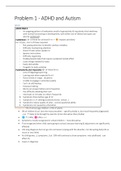Summary
2023 Summary 1.6 Normal Or Abnormal? ALL PROBLEMS (FSWP1-060-A)
- Course
- Institution
Extensive notes of all the mandatory literature for course 1.6 Normal or Abnormal? Written by an Honour Student with relevant visual aids, all DSM V criteria and helpful overviews. I'll be happy if you leave your feedback or review :)!
[Show more]



